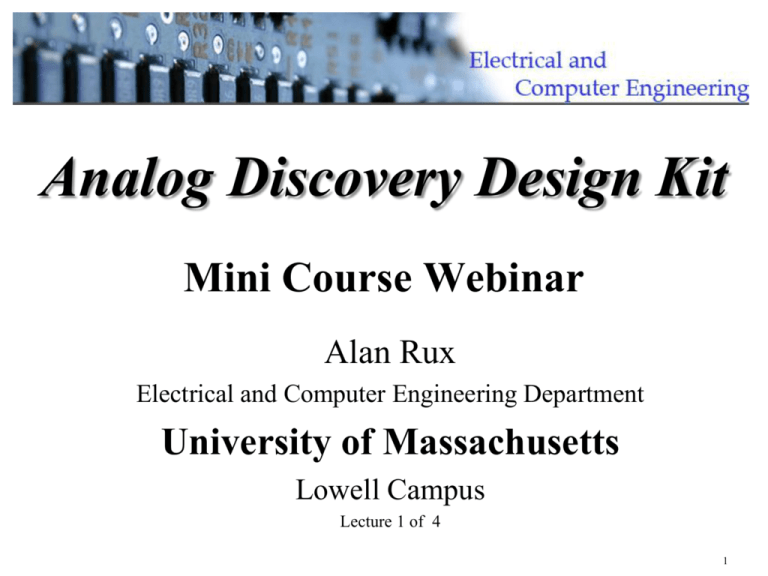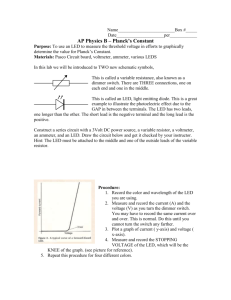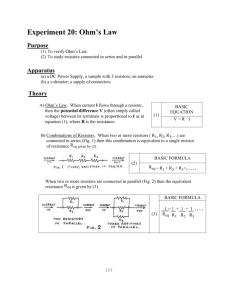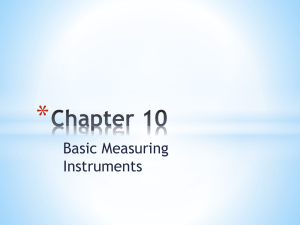mini course intro-1a - Sri Vishnu Educational Society
advertisement

Analog Discovery Design Kit Mini Course Webinar Alan Rux Electrical and Computer Engineering Department University of Massachusetts Lowell Campus Lecture 1 of 4 1 Revolutionizing How Engineering Students Learn Analog Circuit Design 2 Go To Lecture Do Experiments as in the Syllabus “ wire-by-numbers” • three to six student in a Team • one student, builds circuit, takes measurements, fills out lab notebooks • others texts friends & look out into space • one student learns hands-on 3 4 Basic Electronic Lab. 5 the Analog Discovery Design Kit allow students to build and test a wide range of analog and digital circuits using their own PC without the need for any other special test equipment. 6 Active learning – learning by doing helps engineering students understand the process of breaking down larger problems into smaller, more easily solved parts without losing the overall understanding of the complete system. 7 University of Massachusetts – Lowell Campus in partnership with - University Program & DIGILENT Education Tools Indo-US Collaboration for Engineering Education 8 Analog Discovery Design Kit learning by doing 9 Analog Discovery Design Kit • Dual Channel Oscilloscope – – – – – Two channels differential input, 1 Meg ohm, 24pfd +/- 20 volts input max 250 mv. to 5 Volts / division with variable gain settings 100 MSPS, 5 MHz bandwidth, 16K points/channel memory FFT function 10 Analog Discovery Design Kit • 2 Channel, Arbitrary Waveforms Generator – – – – – – – – – – Sine wave Square wave Triangular wave Sawtooth wave Sweep function AM-FM modulation 4 MHz bandwidth, 10 P-P voltage output User defined waveforms Bode function 11 Analog Discovery Design Kit • Power Supply – Two fixed voltages +5 volts / -5 volts, 50 ma. Each – Switchable ON / OFF comands – Unit powered by USB computer port, (cable included) 12 Analog Discovery Design Kit • Logic Analyzer – Pattern Generator – I/O s – – – – – 16 signal channels shared between logic analyzer pattern generator discrete I/O devices 100 MSPS, 4 k buffer per pin Cross triggering with scope channels 13 2 differential input Voltmeters 14 Network Analyzer 10Hz to 5 MHz 15 Analog Discovery Design Kit • Static I / O – o o o o o o PC based virtual I/O device drivers including: push buttons LEDs switches seven segment displays sliders Progress bars 16 Analog Discovery Design Kit • WaveForms Software – Windows XP or newer – full –featured GUI for all instruments 17 Basic Electronic Lab. 18 the Analog Discovery Design Kit allow students to build and test a wide range of analog and digital circuits using their own PC without the need for any other special test equipment. 19 This approach eliminates the time and space limitations of traditional university lab settings and allows students more flexibility to experiment with real circuits through direct hands-on experience 20 Active learning – learning by doing helps engineering students understand the process of breaking down larger problems into smaller, more easily solved parts without losing the overall understanding of the complete system. 21 Indo-US Collaboration for Engineering Education University of Massachusetts – Lowell Campus in partnership with - University Program & DIGILENT Education Tools 22 Analog Discovery Design Kit learning by doing 23 Analog Parts Kit 24 Electrostatic Discharge Hazard Electrostatic discharge (ESD) is the sudden flow of electricity between two objects caused by contact, an electrical short, or dielectric breakdown. ESD can be caused by a buildup of static electricity by tribocharging, or by electrostatic induction. 25 WaveForms Software – Windows XP or newer – full –featured GUI for all instruments 26 Let’s Get Started ! Google “Analog Discovery Kit Digilent” 27 Scroll down page to waveforms 28 Mouse click on “Learn more” 29 Click on 30 Need about 38MBite HD space MS Security Essentials will not be happy 31 Follow set-up wizard’s instructions 32 33 34 If you see this, the Discovery kit is not plugged in to USB port 35 Unit was detected “connect to device” 36 You are now connected 37 Download “a getting started guide for first time WaveForms users” 38 39 Experence the WaveForms software This can be done with or without the Discovery kit , use demo-mode 40 D.C. Circuits Lab. Experiments • • • • • • • Learning the ADK Leads (Analog Discovery Kit) Solder-less breadboard use Power Supply Operation Voltmeter Operation Series Circuits Measurements Superposition Theorem Homework problem 41 42 Time to take the ADK out of the box and connect to a USB port. Connect the Leads to ADK. 43 The Leads are Keyed bottom view color wires with white stripe on bottom, also bottom has small feet pads 44 Note keyway notch 45 Keyway pin 46 ADK top view with leads plugged in ( note solid color wires are on top) 47 Leads are color coded 48 Leads we will be using today 49 To make things easer I use a rubber band to keep the leads I am not using out of the way Not used Leads in use 50 Plug one end into the connector on the end of the leads from the ADK (may be using solid copper 24 awg. insulated wires for leads with ends striped ) 51 Now your lead from the ADK is longer and you can plug the PIN end into your solderless breadboard Time for Questions ? 52 53 54 Analog Discovery Design Kit • Power Supply – Two fixed voltages +5 volts / -5 volts, 50 ma. MAX – Switchable ON / OFF commands – Unit powered by USB computer port, (cable included) 55 With the ADK plugged into your computer USB port, click on the “W” short-cut logo. The status bar of the Waveforms Window should appear and a red LED on the ADK near the place the USB cable plugs into should be on 56 You are now connected 57 If you see this window recheck your USB cable connections and try again 58 To enable the power supplies click on the “Voltage” icon 59 Power Supply Control Panel Main power control +5 volts control -5 volt control Power use indicator 60 Power Supply Control Panel Main power control on +5 volts - on -5 volt - on Power use indicator 61 Power Supply Control Panel Power use indicator max current 70 MA 20 MA 10 MA 62 Power Supply Control Panel power over the 50 MA limit Error message At this time do not allow 1 amp to be drawn 63 Power active 64 To enable the Voltmeter click on the “more instruments” icon 65 Then Voltmeter This will unable 2 channel oscilloscope 66 2 differential input Voltmeters Note two options for Range , use auto range 67 Voltmeter connections Voltmeter #2 + input Voltmeter #1 + input Voltmeter #1 - input Voltmeter #2 - input 68 Two Resistors in Series Measurements V+ Power Supply +5V (red) Using the +5v and -5v supplies = 10 volts across node “A” and “B”, R1 & R2 are 1.0K ohms each. V- Power Supply -5V (white) Voltmeter 1, positive lead (orange) Voltmeter 2, positive lead (blue) Voltmeter 1 & 2, negative leads (orange/white & blue/white) 69 Two Resistors in Series Measurements R2 R1 70 Two Resistors in Series Measurements 71 Three Resistors in Series Measurements V+ Power Supply +5V (red) Using the +5v and -5v supplies = 10 volts across node “A” and “B”, R1, R2 & R3 are 1.0K ohms each. V- Power Supply -5V (white) Voltmeter 1, positive lead (orange) Voltmeter 2, positive lead (blue) Voltmeter 2, negative lead (blue/white) Voltmeter 1, negative lead (orange/white) 72 Three Resistors in Series Measurements R3 R2 R1 73 Three Resistors in Series Measurements 74 Three Resistors in Series Measurements V+ Power Supply +5V (red) Using the +5v and -5v supplies = 10 volts across node “A” and “B”, R1& R3 are 1.0K ohms, R2 is 100 ohms . V- Power Supply -5V (white) Voltmeter 2, positive lead (blue) Voltmeter 2, negative lead (blue/white) Voltmeter 1, positive lead (orange) Voltmeter 1, negative lead (orange/white) 75 Three Resistors in Series Measurements 76 Superposition Theorem • Some circuits require more than one voltage or current source • The superposition theorem is a way to determine currents and voltages in a circuit that has multiple sources by considering one source at a time 77 Illustration of the superposition theorem. Thomas L. Floyd Electronics Fundamentals, 6e 78 Superposition Theorem Problem current IR3 R1, R2, R3, all are 1000 ohms, Vs1=10 volts, Vs2=5 volts 79 Superposition Theorem power supply connections V+ Power Supply +5V (red) Power Supply +/common (black) + 10 v. + 5 v. V- Power Supply -5V (white) R1, R2, R3, all are 1000 ohms, Vs1=10 volts, Vs2=5 volts 80 Superposition Theorem voltmeter connections voltmeter 1 across R3 Voltmeter 1 + Orange lead Voltmeter 1 Orange/white lead 81 Superposition Theorem voltmeter connections voltmeter 2 across R2 Voltmeter 2 + Blue lead Voltmeter 2 Blue/white lead 82 Superposition Theorem connections R1 R3 R2 83 Superposition Theorem Measurements Channel 1 = R3 Channel 2 = R2 Vs1 = 10 v. Vs2 = 5 v. All Rs = 1000 ohms 84 Homework 1. Series Circuits measurements with 2 to 4 resistors 2. Simple Series/Parallel measurements, 5 resistors or more – experiment around 3. Superposition measurements 85 Alan Rux at BVRIT Questions 86





![[11]______ No. of printed pages :04](http://s3.studylib.net/store/data/008230456_1-c7f17f51a590100b54beedcacca16186-300x300.png)

